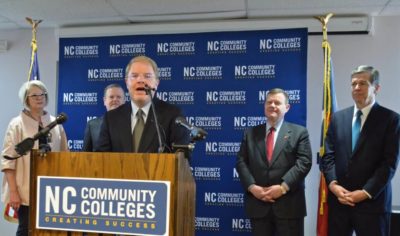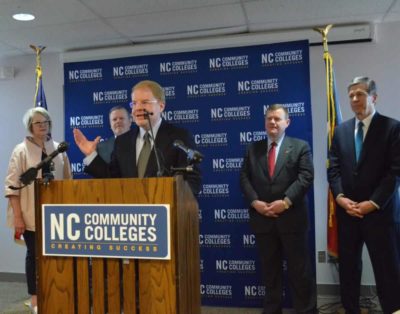
North Carolina’s children need competent, well-trained teachers in every classroom if our state is to keep growing and prospering.
In the coming months, you’ll hear proposals about how North Carolina can improve its K-12 education system and increase the supply of teachers, particularly those willing to work in low-wealth and rural districts. This will be a huge task and one that will require sustained diligence in order to hire and retain enough teachers.
There isn’t one answer. We must approach teacher recruitment and preparation with a wide net.
The NC Community College System stands ready to help. With 58 colleges serving 100 counties, the community colleges are in the best position to quickly build a teacher pipeline in underserved areas and attract a more diverse teacher corps.
We propose a couple of new approaches.
First, community colleges have begun to plan an associate degree in teacher education. The specialized transfer degree is designed as a seamless pathway from high school to community college to a four-year institution.
It just makes sense. Community colleges already have strong relationships with the public schools through the growing popularity of Career and College Promise, which provides nearly 60,000 high school students with community college courses annually. This program enhances our ability to reach into high schools and recruit future teachers.
At the same time, community colleges have solid transfer agreements with UNC and private universities. This puts community colleges in a unique position at the center of what could be a new, accelerated teacher training model, drawing on the strengths of all sectors. Our goal is to design the degree program as an affordable option, attracting young people into the teaching profession with the help of scholarships and other support.
Second, the community colleges will seek approval to offer education courses for working adults who want to become teachers. This would provide a streamlined pathway for those with bachelor’s degrees to earn a license and move into a new career. So many people want to teach in North Carolina classrooms, but can’t uproot their lives to enter traditional teacher education programs. Having courses available at local community colleges would no doubt increase the number of lateral entry teachers, including those with much-needed expertise in STEM fields.
As we develop these two new teacher training models, we will infuse our courses with practices known to be effective.
Every future teacher needs to understand the science of reading, and what methods are likely to be most successful in literacy. If we focus on evidence-based techniques, the courses can also help retool local teachers who may need it. School districts are changing reading instruction in order to boost achievement in early grades, but not all teachers have the background they need to do the job.
Building an adequate pipeline of qualified teachers is proving difficult in the state. At a time when the state’s population continues to grow, enrollment in teacher education programs at UNC institutions has declined by 29% from 2011 to 2018. Fewer young people seem willing to commit to a career in teaching.
While the teacher turnover rate has declined slightly, a shortage remains, especially in the state’s rural areas. Last year, more than 7,000 North Carolina educators, or 7.5%, left the classroom. But the attrition rate is dramatically worse in some areas — 17.3% in Tyrrell County and 15.9% in Northampton County, for example.
Community colleges have the best chance of helping rural counties “grow their own” teachers. Our goal is to recruit teachers from underrepresented populations and those who are more likely to settle near home. Community colleges already have a similar model in place to increase nursing graduates in underserved regions through a program of dual admission to the community college and university.
A new journey to becoming a teacher could start in high school. A student could take general courses at a community college while also participating in a teacher education pathway for high school students, now under development. The second year of instruction could occur at a community college and include a university component. The final part of the program would be provided by the four-year institution, online or in the local community. Along the way, students could have advisers at both the community college and university.
This new pathway would, of course, require additional agreement on common courses among the community colleges and universities. But this could be overcome as long as educators and policy makers keep the end goal in mind — a robust, diverse pool of future teachers to serve all geographic areas of the state.
For decades, the landmark Leandro court case has helped focus our attention on the needs in North Carolina public schools. Now it’s time to meet the mandate and make sure all students, in all school districts, have a sound education. That starts with great teachers. Community colleges can help our state achieve this important goal.




